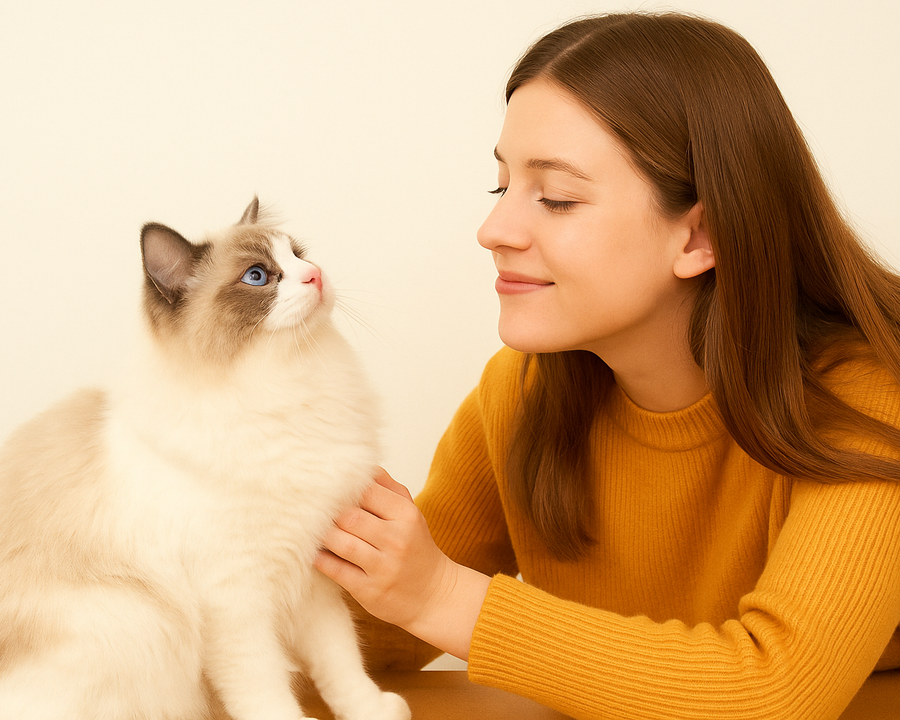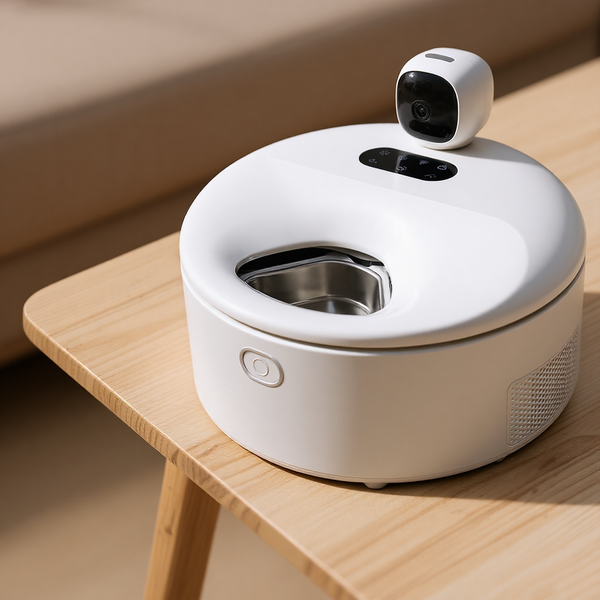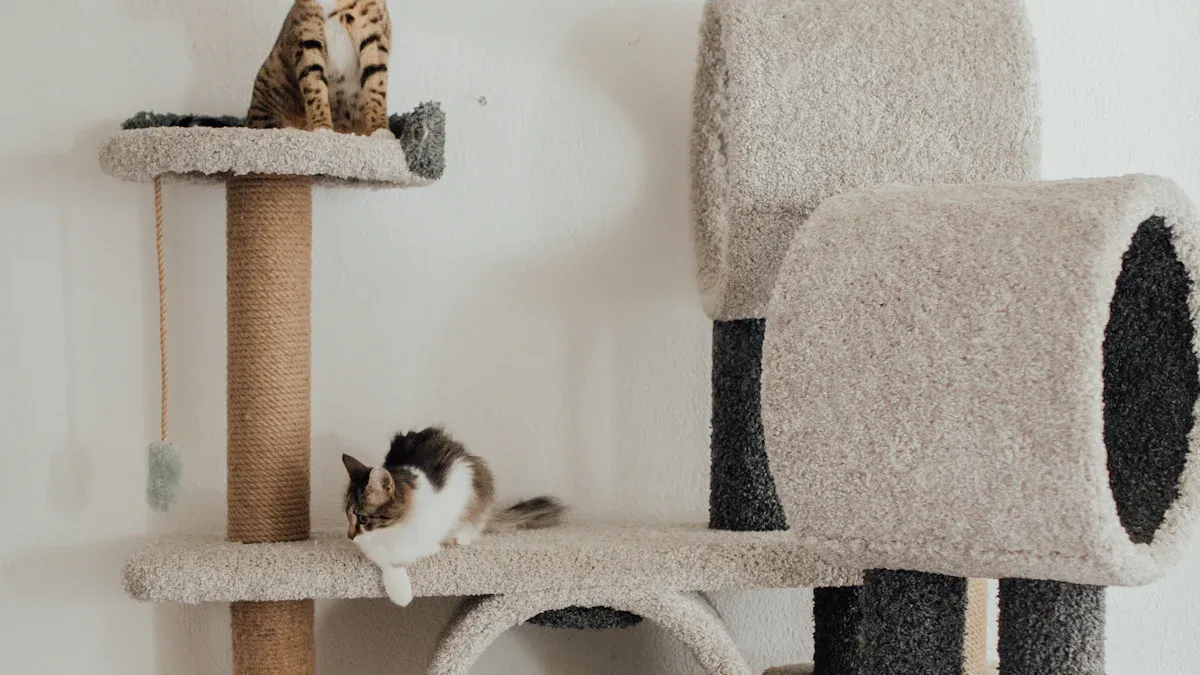
Welcome to cat parenthood! You probably feel excited and a little nervous. Many new owners find that giving enough attention, choosing good food, and keeping the litter box clean can be tough at first. A Cat Starter Kit helps you meet these needs, making your cat feel happy and secure from day one.
Key Takeaways
-
A Cat Starter Kit has important things your new cat needs. These items help your cat feel safe and happy right away. - Put good food, a soft bed, and a litter box in your kit. These things help your cat stay healthy and feel good. - Groom your cat often and take it to the vet. Start these habits early for a healthy and happy cat.
What’s in a Cat Starter Kit?
Why a Starter Kit Matters
You want your new cat to feel safe and happy right away. A Cat Starter Kit helps you do just that. It gives you all the basics you need, so you do not have to worry about missing anything important. Pet care experts say these kits make the first days much easier for both you and your cat. You get everything in one place, which saves you time and stress.
A starter kit helps you build a strong bond with your cat from day one. It creates a cozy and safe space, making the transition smoother for everyone.
Here are some ways a starter kit helps:
-
Gives your cat a comfortable and safe environment
-
Makes sure you have all the essentials from the start
-
Reduces stress for you and your cat
Essential Components
You might wonder what goes inside a good starter kit. Most kits include items that vets and pet experts recommend. These items help you care for your cat’s health, comfort, and play needs.
-
Grooming supplies like nail clippers, a toothbrush, and cat toothpaste
-
Training tools such as treats or a clicker
-
First aid supplies for small emergencies
-
Scratching posts or pads to keep claws healthy
-
Litter box and litter for easy clean-up
-
Collar with a bell so you can hear your cat
-
Two toys for playtime
-
Food and water bowls
With these essentials, you can welcome your new friend with confidence. Your Cat Starter Kit sets you up for a happy start together.
Quality Cat Food
Feeding your cat high-quality food is one of the best ways to support a long, healthy life. The right food gives your cat energy, keeps their coat shiny, and helps prevent health problems. You want to make sure every meal counts.
Wet vs. Dry Food
You might wonder if wet or dry food is better for your cat. Both have their own benefits and drawbacks. Here’s a quick look:
|
Type of Food |
Benefits |
Drawbacks |
|---|---|---|
|
Wet Cat Food |
High water content, more protein, fewer carbohydrates, good for dental issues |
Expensive, quickly perishable, less nutrient-dense |
|
Dry Cat Food |
Affordable, convenient, long shelf life |
Lower water content, less protein, may lead to obesity |
Wet food helps keep your cat hydrated, which is great for urinary health. It also has more animal protein, which cats need. Dry food is easy to store and serve, but it can lead to overeating if you leave it out all day.
Tip: Many cat owners use both wet and dry food to give their cats variety and balanced nutrition.
Choosing the Right Food
When picking food, always check the label for these essentials:
-
Proteins and Amino Acids: Look for meat, poultry, fish, or eggs as main ingredients.
-
Fat and Fatty Acids: These support energy and a healthy coat.
-
Vitamins and Minerals: Make sure the food meets AAFCO standards.
-
Water: Especially important if your cat eats mostly dry food.
Kittens need more protein and fat to help them grow. Adult cats do best with balanced food that matches their activity level and health needs.
If you want to make mealtime easier, try the Polar Smart Wet Food Feeder by Petcantalk. With just one click, you can serve fresh wet food—no mess, no fuss. Your cat will love it, and you’ll love the convenience!
Food and Water Bowls
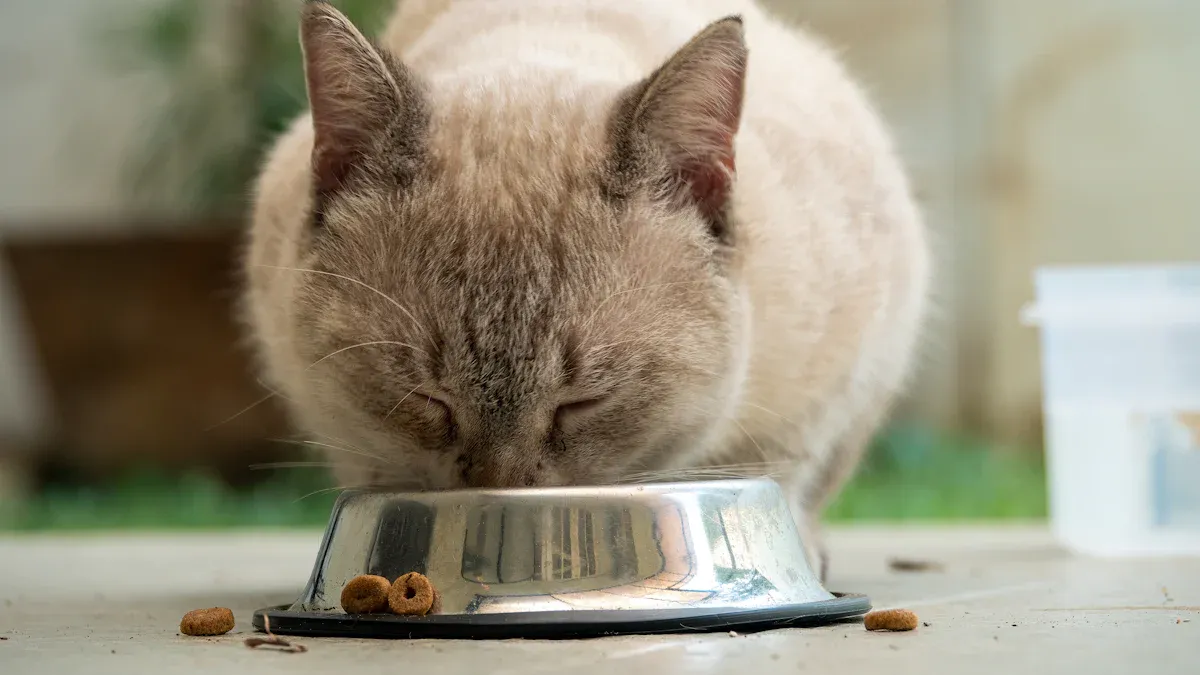
Material Choices
Choosing the right food and water bowls matters more than you might think. The material you pick affects your cat’s health and comfort. Some bowls are safer and last longer than others. Here’s a quick look at the most common options:
|
Material |
Safety Features |
Durability Features |
|---|---|---|
|
Glass |
Non-porous, non-toxic, dishwasher-safe |
Stable, but check for lead in some imported glass |
|
Stainless Steel |
Safe, doesn’t hold germs, can be sterilized |
Very strong, resists scratches |
|
Ceramic |
Safe if labeled lead-free and food-safe |
Can chip or crack, check for toxic glazes |
|
Plastic |
Not recommended; can harbor germs and harmful chemicals |
Scratches easily, less durable |
Most cat owners love stainless steel bowls. They are safe, easy to clean, and don’t hold germs. Glass bowls also work well if you make sure they are lead-free. Ceramic bowls look nice, but always check for a food-safe label. Try to avoid plastic bowls. They can trap bacteria and may contain chemicals that are not good for your cat.
Tip: Shallow, wide bowls help prevent whisker fatigue. Your cat will eat and drink more comfortably.
Easy Cleaning Tips
Keeping your cat’s bowls clean helps prevent sickness and keeps water fresh. Here are some simple ways to make cleaning easy:
-
Wash bowls daily with hot, soapy water. Stainless steel and glass can go in the dishwasher.
-
Rinse well to remove any soap. Cats can taste leftover soap, and it might stop them from eating.
-
Check for scratches or chips. Replace bowls if you see damage, since germs can hide there.
-
Dry bowls completely before refilling to stop mold from growing.
-
Use separate bowls for food and water to keep things tidy.
A clean bowl means a happy, healthy cat. You’ll notice your cat enjoys mealtime more when their dishes stay fresh and safe!
Litter Box and Supplies
High-Sided Litter Box
A good litter box keeps your home clean and your cat happy. High-sided litter boxes work well because they help stop litter from spilling onto the floor. Your cat can dig and cover waste without making a mess. Some boxes even look like furniture, so they blend in with your room.
Here’s what you should look for in a litter box:
|
Feature |
Description |
|---|---|
|
Enclosures trap smells, especially with quality litter. |
|
|
Aesthetic Appeal |
Hides the box, keeps your room looking nice. |
|
Litter Tracking Reduction |
Barriers or mats stop litter from spreading. |
|
Dual Functionality |
Some boxes double as furniture. |
|
Cat Comfort |
Gives privacy, helps your cat feel safe. |
If you want a simple solution, the Petcantalk Cat Starter Kit includes a sturdy litter box with high sides and a matching scoop. This makes cleanup easy and keeps your space tidy.
Litter and Scooper
Choosing the right litter makes a big difference. You want something that controls odor and is easy to clean. Here are some popular types:
-
Clumping Clay Litter: Absorbs well and makes scooping simple. It locks in smells fast.
-
Silica Gel Litter: Uses beads to soak up liquid and trap odors. It’s light and doesn’t make much dust.
-
Biodegradable Litter: Made from corn or wheat. It’s better for the planet, but odor control can vary.
A good scooper helps you remove waste quickly. The scoop in the Petcantalk Cat Starter Kit fits the box perfectly, so you can keep things fresh with less effort. Clean the box every day to keep your cat healthy and your home smelling good.
Cozy Cat Bed
Comfort and Security
Your cat loves having a special spot to curl up and relax. A dedicated cat bed gives your furry friend ultimate comfort and warmth. Soft beds support your cat’s body, making nap time extra cozy. You’ll notice your cat feels safer in a bed that mimics a natural den. Enclosed beds help reduce stress and anxiety, especially for shy or nervous cats. Cats enjoy privacy and solitude, so a cave-style bed can make them feel protected. When your cat has a personal bed, you keep your furniture cleaner. Less fur and dander end up on your couch and chairs, which means a tidier home for you.
When you choose a bed, look for materials that help your cat sleep well. Fleece feels soft and luxurious, perfect for all breeds. Denim offers style and durability, plus it resists scratching. Cotton, especially organic, creates a relaxing and comfortable space. Latex supports your cat’s body, just like a good mattress. Some beds use coco coir, which adds a natural touch and extra comfort.
Tip: Cats love warmth. Pick a bed that keeps your cat cozy, especially in colder months.
Bed Placement
Where you put the bed matters. Place it in a quiet corner where your cat feels safe. Avoid busy areas with lots of noise. Cats like to watch what’s happening, so a spot near a window works well. Make sure the bed stays away from drafts and direct sunlight. If you have more than one cat, give each their own bed. This helps prevent fights and keeps everyone happy.
You’ll see your cat use the bed more if it’s in a spot they like. Try moving the bed around until you find the perfect place. Your cat will show you where they feel most comfortable!
Scratching Post
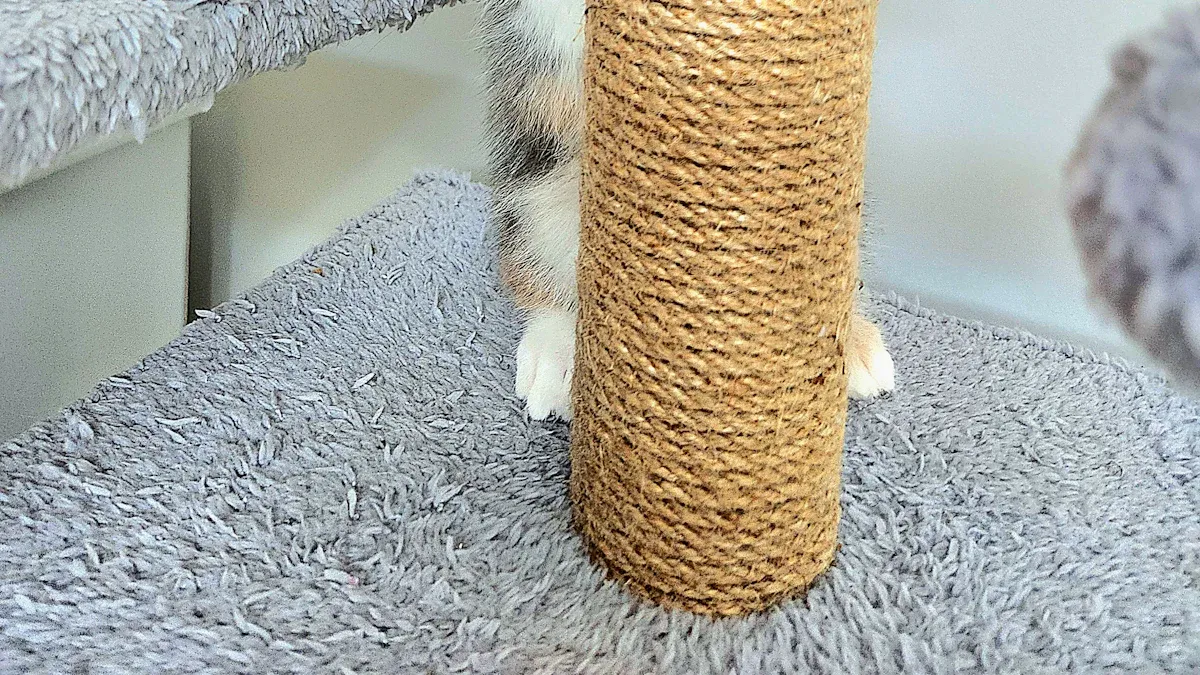
Claw Health
Your cat needs to scratch. It is not just a habit—it is a way to stay healthy and happy. Scratching helps your cat shed the outer layer of their claws. This keeps their nails sharp and prevents painful ingrown claws. When your cat uses a scratching post, they also stretch their muscles and keep their body flexible. Scratching gives your cat a burst of energy and helps them feel good. It even helps with stress. If your cat feels anxious, scratching can calm them down.
Here is a quick look at how a scratching post helps your cat:
|
Benefit Type |
Description |
|---|---|
|
Claw Health |
Removes the outer sheath, lowers risk of ingrown claws |
|
Weight Management |
Gives exercise, helps control weight |
|
Stretch Necessity |
Promotes muscle flexibility, prevents stiffness |
|
Endorphin Essential |
Releases endorphins, boosts mood |
|
Stress Relief |
Soothes your cat, eases anxiety |
|
Marking Territory |
Lets your cat leave their scent and claim their space |
Tip: Place the scratching post where your cat likes to hang out. This makes it more likely they will use it.
Types of Scratchers
Not all cats scratch the same way. Some like to reach up high, while others prefer to scratch along the floor. You can find many types of scratchers to match your cat’s style.
|
Type of Scratching Post |
Benefits |
|---|---|
|
Vertical Posts |
Great for cats who love to stretch and climb |
|
Horizontal Posts |
Perfect for cats who scratch while lying down |
|
Combination Posts |
Offers both vertical and horizontal options |
|
Materials (Sisal, Carpet, Cardboard, Wood) |
Each texture gives a different feel and lasts a different amount of time |
Try a few styles to see what your cat likes best. Some cats enjoy rough sisal, while others go for soft carpet or cardboard. A good scratching post keeps your cat busy and saves your furniture from sharp claws!
Cat Toys
Play and Enrichment
Your cat needs playtime every day. Toys help your cat stay active, burn energy, and fight boredom. When you play with your cat, you also build a stronger bond. Cats love to chase, pounce, and hunt. The right toys can turn your living room into a fun playground.
Here are some toys that keep cats happy and healthy:
-
Margaritaville Flip Flop Ropes: Great for chasing and pouncing.
-
High Kickers from Fuzzu: Perfect for kicking and wrestling.
-
Safari Feather Mice Cat PDQs: Move like real prey and spark hunting instincts.
-
Cat Teaser with Interchangeable Attachments: Offers new challenges and keeps playtime fresh.
-
Lamb Chop Cat Wand with Refillable Catnip: Adds excitement with catnip and interactive play.
-
Felt Fish Cat Wand: Encourages jumping and pouncing.
-
Mesh Ball Cat Toys: Simple toys for solo play and chasing.
Tip: Rotate your cat’s toys every week. This keeps things interesting and prevents boredom.
Safe Toy Choices
Safety comes first when you pick toys for your cat. Some toys look fun but can be risky. Always check toys before giving them to your cat.
Keep these safety tips in mind:
-
Avoid toys with strings or small parts that can be swallowed.
-
Stay away from toys with removable feathers or buttons.
-
Pick toys that do not have sharp edges or small openings.
-
Make sure the toy is the right size for your cat.
-
Check toys often for damage or loose pieces.
A safe toy means more fun and less worry. Your cat will thank you with happy purrs and playful leaps!
Cat Carrier
Travel Safety
You want your cat to feel safe when you travel. A strong cat carrier keeps your cat secure on trips. It works for vet visits or long car rides. Cats can get scared in new places. A good carrier helps them feel protected and calm. Pick carriers made from tough nylon or polyester. These last a long time and are easy to clean. Many carriers have soft bedding you can wash. This makes the ride comfy and keeps things clean.
Good airflow is important. Mesh panels let air move through the carrier. They also let your cat see outside, which can help them relax. Some carriers have flaps for privacy if your cat likes darkness. Safety is very important. Choose a carrier with seatbelt straps or tethers. These keep the carrier from moving during car rides. If you want to fly, look for airline-approved carriers. These follow travel rules and make flying easier.
Here’s what to look for:
|
Feature |
Description |
|---|---|
|
Construction |
Made from strong nylon or polyester, often with bedding you can wash. |
|
Size Options |
Comes in small, medium, or large sizes for different cats. |
|
Weight Capacity |
Holds certain weights, like up to 22 pounds, for safety. |
|
Ventilation |
Mesh panels give air and let your cat see out, which lowers stress. |
|
Safety Measures |
Has tethers, privacy flaps, and seatbelt straps for safe travel. |
|
Airline Approval |
Meets airline rules for in-cabin travel, so you can fly with your cat. |
Size and Features
Getting the right size carrier is important for your cat. Your cat should stand, sit, turn, and lie down inside. Experts say the carrier should be about one and a half times your cat’s size. If your cat is between sizes, pick the bigger one. More space helps your cat feel less stressed.
Here are some tips for picking the right size:
-
Your cat should stand, turn, and lie down in the carrier.
-
If you are not sure, choose the bigger size.
-
Do not get a carrier that is too big, because it is hard to carry and may not feel cozy.
A good carrier makes every trip safer and more comfortable. With the right features, you and your cat can travel with less worry.
Identification
Making sure your cat can be identified is one of the best ways to keep them safe. If your cat ever slips outside or gets lost, having the right ID can help bring them home faster. You have two main options: collars with tags and microchips. Each has its own benefits.
Collar and Tag
A collar with a tag is the most visible way to show your cat belongs to you. Anyone who finds your cat can see your contact information right away. You can choose a breakaway collar for safety, so your cat won’t get stuck. Add a tag with your phone number and your cat’s name. This simple step can make a big difference if your cat wanders off.
Did you know? Pet detectives and lost pet recovery services help recover 57% of lost cats alive. Having a collar and tag makes their job easier and increases your chances of a happy reunion.
Microchip Option
Microchipping gives your cat a permanent form of identification. A vet places a tiny chip under your cat’s skin. If your cat gets lost, a shelter or vet can scan the chip and contact you. Microchips last a lifetime and don’t need batteries. Just remember to keep your contact info up to date in the registry. If the information is wrong, the chance of getting your cat back drops from 75% to 41%.
Here’s a quick look at the pros and cons of each method:
|
Method |
Pros |
Cons |
|---|---|---|
|
Microchipping |
Permanent, lasts a lifetime, no battery |
Needs scanning, info must stay updated, small infection risk |
|
Collars and Tags |
Easy to see, quick contact |
Can fall off or get lost, less reliable than microchips |
Many cat owners use both methods for extra peace of mind. When you build your Cat Starter Kit, don’t forget to include a collar and tag, and ask your vet about microchipping.
Grooming Tools
Keeping your cat clean and healthy starts with the right grooming tools. You want your cat to look great and feel comfortable. Regular grooming helps prevent mats, reduces shedding, and keeps skin problems away. The Cat Starter Kit from Petcantalk includes everything you need to get started.
Brushes and Combs
You’ll find that different cats need different brushes. Long-haired cats do best with a slicker brush or a wide-toothed comb. These tools help remove tangles and loose fur. Short-haired cats love bristle brushes because they make the coat shiny and smooth. Grooming gloves work for all fur types and make brushing easy. Some cats enjoy the gentle touch of a dual-sided brush, which detangles and spreads natural oils.
Tip: Use the right brush for your cat’s coat. This keeps grooming quick and stress-free.
Here’s a quick guide:
-
Slicker brush: Stops matting for long-haired cats.
-
Dual-sided brush: Detangles and spreads oils for medium fur.
-
Bristle brush: Adds shine for short-haired cats.
-
Grooming gloves: Removes loose fur gently.
-
Wide-toothed comb: Untangles knots in long fur.
-
Dematting comb: Handles tough mats.
-
Shedding comb: Reduces shedding for all cats.
How often should you groom? Check out this table:
|
Coat Type |
Recommended Grooming Frequency |
|---|---|
|
Short-haired cats |
|
|
Long-haired cats |
Daily or several times a week |
Nail Clippers and Wipes
Trimming your cat’s nails keeps them from getting too sharp or snagging on things. You want to use a nail clipper made for cats. The Petcantalk Cat Starter Kit includes a safe nail clipper, so you can trim with confidence. Pet wipes help clean paws and fur, especially after playtime or litter box visits. These wipes are gentle and easy to use. You can also use no-rinse gloves for a quick clean-up.
Note: Regular nail trims and gentle cleaning help your cat stay healthy and happy.
Health Essentials
Vet Visit
Your cat’s health starts with a good first impression at the vet. You want to make sure your new friend feels safe and cared for right away. Most experts recommend you schedule your cat’s first vet visit within the first week after adoption. This visit helps set a health baseline and builds trust with the vet. If you notice your kitten acting sick or not eating, do not wait—take them to the vet as soon as possible.
Here’s a quick checklist for your new cat’s first vet visits:
-
Schedule the first vet visit within the first week of adoption.
-
Watch for signs of illness, like sneezing, coughing, or not eating. Visit the vet right away if you see these.
-
Adopt kittens between 8 and 10 weeks old for the best start in life.
Tip: Bring a favorite toy or blanket to the vet. This can help your cat feel more comfortable during the visit.
Health Boosters
You want your cat to grow strong and stay healthy. Some supplements can give your kitten an extra boost, especially in the first year. These health boosters support brain growth, strong bones, and a happy tummy.
Here are some common health boosters for kittens:
-
DHA (Omega-3 fatty acid): Helps with brain and vision development.
-
Probiotics: Keeps your cat’s gut healthy and supports digestion.
-
Calcium and Phosphorus: Builds strong bones and teeth.
Ask your vet before starting any supplement. Every cat is different, so your vet can help you choose what’s best. With the right care, your cat will thrive and bring you joy every day!
Before you bring your cat home, check your list. Make sure you have everything ready. Set up a quiet room for your cat. Give them food, water, and litter. This helps your cat feel less stressed. Your cat will adjust faster.
-
A special space helps your cat settle in.
-
Having supplies ready makes things easier.
-
Quiet time helps your cat relax.
A Cat Starter Kit saves you time. It keeps your pet safe. Here are some long-term benefits:
|
Benefit |
Description |
|---|---|
|
Simplifies Cat Care |
Gives you all the basics in one box. You do not need to look for each item. |
|
Reduces Stress |
Makes sure you have what you need. You do not have to worry about missing anything. |
|
Ensures Comfort and Safety |
Has soft beds and scratching boards. These help your cat feel safe and comfortable. |
Cat owners say starter kits help them start fast. They work well for families. You show you care by getting ready early. Enjoy your new cat! 🐾
FAQ
What should you do if your cat ignores the new bed?
Try moving the bed to a quiet spot. Add a favorite blanket or toy. Your cat may need time to adjust.
How often should you clean the litter box?
Scoop waste every day. Wash the box with mild soap once a week. Your cat will appreciate a fresh, clean space.
Can you use regular human shampoo for your cat?
No, you should use shampoo made for cats. Human shampoo can irritate your cat’s skin and cause discomfort.



